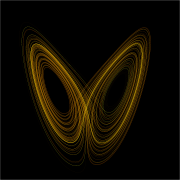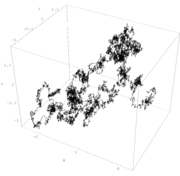- Air Homepage
- Weather Satellites
- What Is the Butterfly Effect
What is the butterfly effect?
Search for more advanced meteorology.
You may wonder… what is the butterfly effect theory?
Butterfly Effect: The Wild Science 🦋Could a butterfly's wing flapping today cause a tornado on another continent next month? Discover how the Butterfly Effect explains why long-term weather forecasting is impossible and how your smallest decisions can ripple out to change the whole future by diving into the mind-bending secrets of Chaos Theory.
Image from a Lorenz Attractor - Mathematically, the Lorenz Attractor represents the chaotic behavior of a simplified weather system. Three nonlinear differential equations describe convection, temperature differences, and air movement. Attractors have unpredictable patterns, often resembling butterflies with interwoven curves. Developed by Edward Lorenz, it illustrates the sensitivity to initial conditions and the limitations of predictability in complex systems.
Researchers and artists continue to be intrigued by the Lorenz Attractor, which has found applications in a variety of scientific fields.
Butterfly Effect: Small actions, big results
Interested in the butterfly effect? Here are some random things to get you thinking:
- small actions can have big consequences.
- simple experiments can show cause and effect. Imagine how dropping a small object in water creates ripples that spread out, symbolizing the ripple effect of actions.
- we often see diagrams, illustrations and videos illustrate the butterfly effect and how small changes in initial conditions can lead to big results. you might notice a butterfly effect, in a drawing, painting or a collage.
- ever been to a butterfly garden? butterflies interact with their environment and their actions can affect it.
- how can seemingly unrelated events can be connected? how can your own actions can affect other people.
- you might even see books, movies, and documentaries that explain the butterfly effect or show the impact of small actions.
In business, the butterfly effect is the idea that small changes or decisions can have big consequences. Here's how the butterfly effect might work in business:
- Business decisions, like pricing adjustments, marketing changes, or product design tweaks, can have a big impact on overall performance. It's these seemingly insignificant choices that shape customer perceptions, market positioning and business success.
- Consumer preferences, market trends, or technological advancements can ripple across industries. When one company innovates or disrupts, it can lead to a cascade of changes and force competitors to adapt, transforming the whole market.
- A small disruption in the supply chain, like a late raw material delivery or a quality issue with a component, can affect production schedules, customer orders, and ultimately, customer satisfaction. Disruptions like these can hurt the company's reputation, financial performance, and stakeholder relationships.
- The actions and decisions of employees can shape the company's culture and overall performance, no matter how small. Productivity, innovation, and customer satisfaction can be increased with a positive work environment, effective collaboration, and a commitment to excellence. Conversely, negative behaviors or complacency can hurt team dynamics.
Understanding the butterfly effect in business can help people and organizations make better decisions. They can see how different parts of a business ecosystem are interconnected and realize how seemingly small choices can have big consequences. This concept encourages a proactive and thoughtful approach to decision-making, fostering a culture of continuous improvement.
In general, we see things like the butterfly effect in all aspects of our lives. Does the butterfly effect have anything to do with chaos theory? This describes effects of much greater magnitude from seemingly insignificant causes.
Meteorology is the source of the butterfly effect.
Small changes in initial conditions can have big, unpredictable effects on a system. Chaos theory uses it to explain why long-term predictions of complex systems are impossible.
This term is often used in weather forecasts. What's the butterfly effect? Do you think a butterfly flapping can cause a tornado somewhere else?
A small input can have big effects. Think of a ball on top of a mountain. The slightest difference in pressure from the tip of a mountain can decide where the ball goes.
In addition, it can accumulate snow on the way down and eventually flatten a town. As with the initial pressure on the ball, the butterfly effect suggests that weather at one place might be related to changes in atmospheric conditions elsewhere some time ago.
Chaos Theory describes the behavior of nonlinear dynamic systems. Initial conditions have a big impact on them.
Chaos theory also applies to predicting the behavior of heavenly bodies, turbulent fluids, and plate tectonics. You can also leave the physical science arena by studying economics, demographics, and historical reasoning.
What is the butterfly effect describing?
There's order...and disorder. We can't make weather predictions more than a week in advance because the atmosphere is delicate-fluid. We couldn't predict the wind caused by a butterfly fluttering even if we could simulate the entire atmosphere.
What is the butterfly effect, really? Probably exaggerated. It's amazing how one insect can make such a difference. You never know.
A measurable change in the atmosphere here can lead to other changes there. And a small change in atmospheric conditions can affect another continent. Maybe a decade from now, and we'll never know. There's a chance.
To predict winds or air movements in the environment, a good weather decision network uses an air turbulence model or an atmosphere simulation. Even then, it might not be enough to predict how the atmosphere will behave in the future.
There's no meteorological monitoring system yet that can resolve the effects of a butterfly or something bigger, like a house fire, for instance.
The method met-people use to combat this chaos theory butterfly effect thing would be, ideally, to take as many readings from as many different places as possible over oceans and atmosphere and combine them.
However, knowing what we know about the butterfly effect, it won't be completely possible. Go back from What is the Butterfly Effect to the
Image Satellite Weather webpage.
Search this site for more information now.
How does the Butterfly Effect work? Would you really like to know?
Find out what is the butterfly effect and how little changes in the air here can lead to major changes elsewhere. Strangely enough, this is true.
Do you have concerns about air pollution in your area??
Perhaps modelling air pollution will provide the answers to your question.
That is what I do on a full-time basis. Find out if it is necessary for your project.
Have your Say...
on the StuffintheAir facebook page
Other topics listed in these guides:
The Stuff-in-the-Air Site Map
And,
Thank you to my research and writing assistants, ChatGPT and WordTune, as well as Wombo and others for the images.
OpenAI's large-scale language generation model (and others provided by Google and Meta), helped generate this text. As soon as draft language is generated, the author reviews, edits, and revises it to their own liking and is responsible for the content.





New! Comments
Do you like what you see here? Please let us know in the box below.